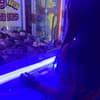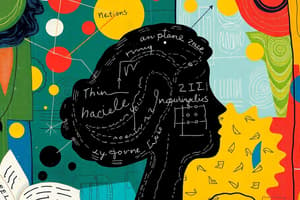Podcast
Questions and Answers
What distinguishes a short story from a novel?
What distinguishes a short story from a novel?
- A short story is typically longer than a novel.
- A short story contains a series of disconnected events.
- A short story develops multiple characters.
- A short story focuses on a single idea. (correct)
Which of the following best defines 'theme' in literature?
Which of the following best defines 'theme' in literature?
- The specific setting of the narrative.
- A character's personal journey.
- The plot outline of the story.
- The underlying meaning in a work. (correct)
Which type of character undergoes significant development throughout a story?
Which type of character undergoes significant development throughout a story?
- Protagonists only
- Static characters
- Dynamic characters (correct)
- Flat characters
What is the primary purpose of drama as a literary genre?
What is the primary purpose of drama as a literary genre?
What is the principal characteristic of poetry?
What is the principal characteristic of poetry?
In literature, what role does the antagonist play?
In literature, what role does the antagonist play?
What does the plot of a story refer to?
What does the plot of a story refer to?
Which of the following is NOT a type of character in literature?
Which of the following is NOT a type of character in literature?
What is the main purpose of the exposition in plot structure?
What is the main purpose of the exposition in plot structure?
Which type of conflict involves a struggle between a character and society?
Which type of conflict involves a struggle between a character and society?
What type of narration is characterized by a single character telling the story using the personal pronoun 'I'?
What type of narration is characterized by a single character telling the story using the personal pronoun 'I'?
Which term describes a concrete object or scene that abstracts into another dimension of meaning?
Which term describes a concrete object or scene that abstracts into another dimension of meaning?
Which kind of irony occurs when a character is unaware of crucial information that the audience knows?
Which kind of irony occurs when a character is unaware of crucial information that the audience knows?
What does the falling action in a plot indicate?
What does the falling action in a plot indicate?
In imagery, which type specifically relates to what can be smelled?
In imagery, which type specifically relates to what can be smelled?
Which figure of speech involves making a comparison without using 'like' or 'as'?
Which figure of speech involves making a comparison without using 'like' or 'as'?
Study Notes
Literature
- Any written work in verse or prose
- Presents everlasting or universal ideas
- Uses different forms of expression
Literary Genres
- Short Story
- Single idea developed
- Concise narration
- Minimal character development
- Economy of setting
- Brevity and density are key traits
- Novel
- Fictional prose narrative of considerable length
- Explores human experiences
- Connected sequence of events
- Includes a cast of characters in a specific setting
- Drama
- Composition in verse or prose
- Depicts life or characters
- Usually involves conflict and emotion
- Designed for performance
- Poetry
- Composition in verse
- Utilizes imagination, emotion, truth, sense impressions
- Uses dignified, rhythmically structured language
Elements of Literature
- Theme
- Underlying meaning in a piece of literature
- Is NOT the subject, plot or summary
- Rarely stated explicitly
- Examples of common themes:
- Appearance vs Reality
- The Individual in Society
- The Journey from Innocence to Experience
- Character
- Presented through:
- Outward appearance
- Significant actions
- Motives for behavior
- Inner thoughts and feelings
- Conflicts
- Choices
- Development
- Flat Characters
- Centered around one main idea or trait
- Round Characters
- More developed and believable
- Consist of multiple traits
- Dynamic Characters
- Develop and grow in response to events
- Static Characters
- Unaffected by events
- Protagonist
- Central character to the action
- Antagonist
- In conflict with the protagonist
- Presented through:
- Plot
- Interconnected series of events
- Shows how conflict or struggle develops
- Internal Conflict
- Character has an inner struggle
- External Conflict
- Character vs. Character
- Character vs. Nature
- Character vs. Society
- Plot Structure
- Exposition: Introduces characters, setting, and background for the story
- Rising Action: Tension builds as conflict intensifies
- Climax: Turning point of greatest tension or emotional response
- Falling Action: Shows the effects of the climax or the working out of the conflict
- Resolution: Shows how the struggle ends and the untying of complications
Method of Narration
- First Person: Told from one character's perspective using the pronoun "I"
- Third Person Limited: The narrator focuses on the thoughts and feelings of only one character
- Omniscient (All Knowing): Narrator knows everything about all characters and events, past, present, and future
- Remember: The narrator is not the author
Setting
- The background to the work of literature
- Includes:
- Space
- Time
- Society
Symbolism
- A symbol is a concrete object, action, character, or scene
- It represents an abstract idea or meaning
Imagery
- Creates a mental picture for the reader
- Taps into the reader’s past experiences and memories
- Allows the reader to imagine and recreate physical scenes
- Kinds of Imagery:
- Visual: What you can see
- Auditory: What you can hear
- Tactile: What you can touch
- Olfactory: What you can smell
- Kinetic: What can move
- Gustatory: What you can taste
Figures of Speech
- Simile: A comparison between two different things using “like” or “as”
- Metaphor: An implied comparison between two different things
- Personification: Human or life-like qualities are given to something non-human
Irony
- Uses a difference between what is said and what is meant
- Kinds of Irony:
- Verbal Irony: What is said is different than what is meant
- Situational Irony: A situation is contrary to what is expected or intended
- Dramatic Irony: Events or facts unknown to a character are known to other characters or to the readers
Foreshadowing
- Technique where the writer hints at future events as the story progresses
Studying That Suits You
Use AI to generate personalized quizzes and flashcards to suit your learning preferences.
Related Documents
Description
Test your knowledge on various literary genres and the essential elements of literature. This quiz covers key concepts such as short stories, novels, drama, and poetry, as well as themes and other critical components that define literary works. Explore the depth of literature and enhance your understanding of its forms and expressions.





